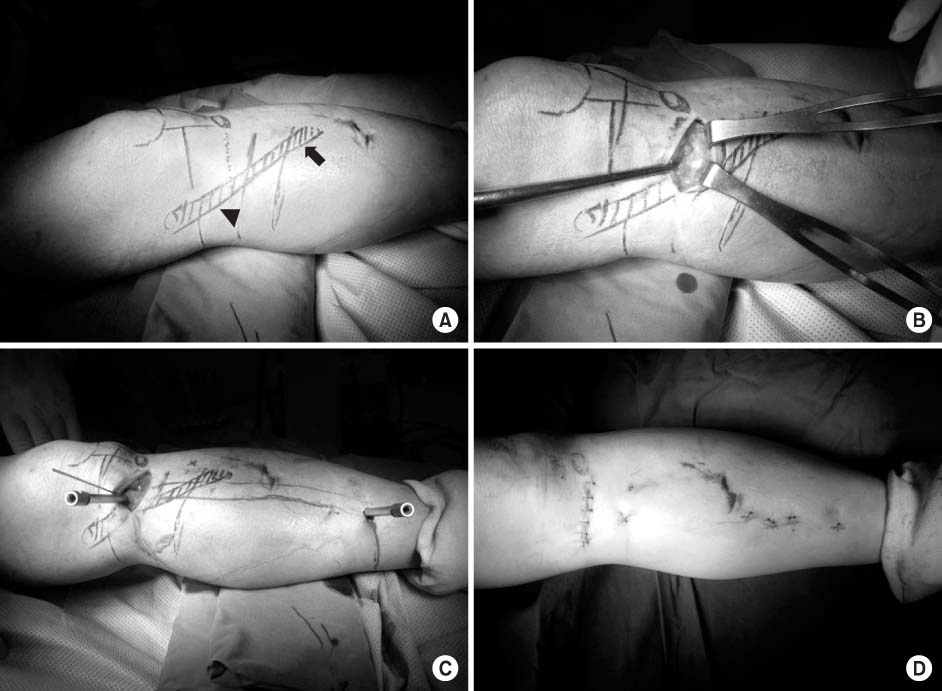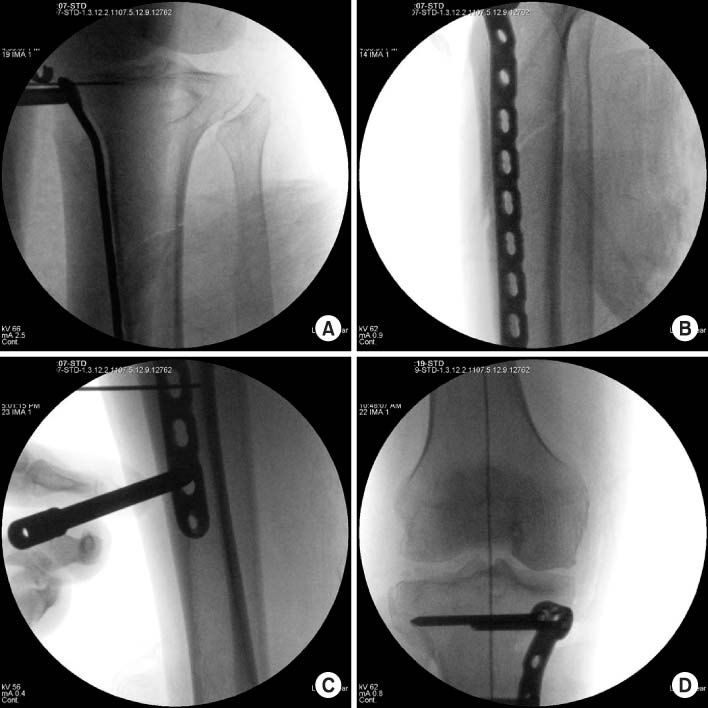Articles
- Page Path
- HOME > J Musculoskelet Trauma > Volume 26(4); 2013 > Article
-
Surgical Technique
- Minimally Invasive Percutaneous Plate Stabilization Using a Medial Locking Plate for Proximal Tibial Fractures: Technical Note
- Jae Ang Sim, M.D., Ph.D., Beom Koo Lee, M.D., Ph.D., Kwang Hui Kim, M.D., Yong Seuk Lee, M.D., Ph.D.
-
Journal of the Korean Fracture Society 2013;26(4):327-332.
DOI: https://doi.org/10.12671/jkfs.2013.26.4.327
Published online: October 18, 2013
Department of Orthopedic Surgery, Gachon University School of Medicine, Incheon, Korea.
- Address reprint requests to: Beom Koo Lee, M.D., Ph.D. Department of Orthopedic Surgery, Gachon University Gil Hospital, 21 Namdong-daero 744beon-gil, Namdong-gu, Incheon 405-760, Korea. Tel: 82-32-460-3384, Fax: 82-32-468-5437, bklee@gilhospital.com
• Received: March 27, 2013 • Revised: July 2, 2013 • Accepted: September 2, 2013
Copyright © 2013 The Korean Fracture Society. All rights reserved.
This is an Open Access article distributed under the terms of the Creative Commons Attribution Non-Commercial License (http://creativecommons.org/licenses/by-nc/3.0/) which permits unrestricted non-commercial use, distribution, and reproduction in any medium, provided the original work is properly cited.
- 622 Views
- 16 Download
- 2 Crossref
Abstract
- Minimally invasive plate osteosynthesis (MIPO) is beneficial for proximal tibial fractures since these injuries are mostly caused by high energy traumas. The advantages of MIPO are minimization of soft tissue dissection and preservation of periosteal vascularization. Lateral plating has mostly developed as MIPO for proximal tibial fractures. We introduce minimal invasive percutaneous plate stabilization using a medial locking plate as alternative treatment for proximal tibial fractures.
- 1. Byun YS, Park KC, Bong HJ, Lee CH. Minimally invasive plate osteosynthesis for proximal tibial shaft fracture. J Korean Fract Soc, 2011;24:23-27.Article
- 2. Cole JD. Intramedullary fixation of proximal tibia fractures. Tech Orthop, 1998;13:27-37.Article
- 3. Dendrinos GK, Kontos S, Katsenis D, Dalas A. Treatment of high-energy tibial plateau fractures by the Ilizarov circular fixator. J Bone Joint Surg Br, 1996;78:710-717.ArticlePubMedPDF
- 4. Ha SH, Kim DH, Lee JY. Treatment of Proximal Tibia Fractures Using LCP by MIPO Technique. J Korean Fract Soc, 2010;23:34-41.Article
- 5. Lang GJ, Cohen BE, Bosse MJ, Kellam JF. Proximal third tibial shaft fractures. Should they be nailed? Clin Orthop Relat Res, 1995;(315):64-74.
- 6. Mullaji AB, Padmanabhan V, Jindal G. Total knee arthroplasty for profound varus deformity: technique and radiological results in 173 knees with varus of more than 20 degrees. J Arthroplasty, 2005;20:550-561.PubMed
- 7. Oh CW, Oh JK, Jeon IH, et al. Minimally invasive percutaneous plate stabilization of proximal tibial fractures. J Korean Fract Soc, 2004;17:224-229.Article
- 8. Park KC. Proximal tibia fracture: plating. J Korean Fract Soc, 2009;22:206-213.Article
- 9. Spagnolo R, Pace F. Management of the Schatzker VI fractures with lateral locked screw plating. Musculoskelet Surg, 2012;96:75-80.ArticlePubMedPDF
- 10. Stannard JP, Wilson TC, Volgas DA, Alonso JE. Fracture stabilization of proximal tibial fractures with the proximal tibial LISS: early experience in Birmingham, Alabama (USA). Injury, 2003;34:Suppl 1. A36-A42.ArticlePubMed
REFERENCES
Fig. 1
Operative procedure.
(A) Drawing of main structures on the skin (arrow: medial collateral ligament, arrow head: the tibial insertion site of hamstring tendon).
(B) Dissecting between the insertion site of the hamstring tendon and that of the medial collateral ligament by Cobb's elevator.
(C) Insertion of a plate through the space between the insertion site of the hamstring tendon and that of the medial collateral ligament.
(D) Suturing.


Figure & Data
REFERENCES
Citations
Citations to this article as recorded by 

- Effect of Korean Medicine Treatments in Patients with Proximal Tibia Fracture: A Retrospective Observational Study
Jung Min Lee, Eun-Jung Lee
Journal of Korean Medicine Rehabilitation.2020; 30(3): 141. CrossRef - Medial Minimally Invasive Percutaneous Plate Osteosynthesis in Proximal Tibial Comminuted Fractures
Jae-Ang Sim, Kwang-Hui Kim, Yong-Seuk Lee, Sang-Jin Lee, Beom-Koo Lee
Journal of the Korean Orthopaedic Association.2014; 49(4): 278. CrossRef
Minimally Invasive Percutaneous Plate Stabilization Using a Medial Locking Plate for Proximal Tibial Fractures: Technical Note


Fig. 1
Operative procedure.
(A) Drawing of main structures on the skin (arrow: medial collateral ligament, arrow head: the tibial insertion site of hamstring tendon).
(B) Dissecting between the insertion site of the hamstring tendon and that of the medial collateral ligament by Cobb's elevator.
(C) Insertion of a plate through the space between the insertion site of the hamstring tendon and that of the medial collateral ligament.
(D) Suturing.
Fig. 2
Fluoroscopic findings.
(A) Temporary proximal fixation by a K-wire.
(B) Accurate positioning of the plate.
(C) Temporary fixation by a K-wire after positioning.
(D) Evaluation of alignment of the lower extremity.
Fig. 1
Fig. 2
Minimally Invasive Percutaneous Plate Stabilization Using a Medial Locking Plate for Proximal Tibial Fractures: Technical Note

 E-submission
E-submission KOTA
KOTA TOTA
TOTA TOTS
TOTS

 Cite
Cite

